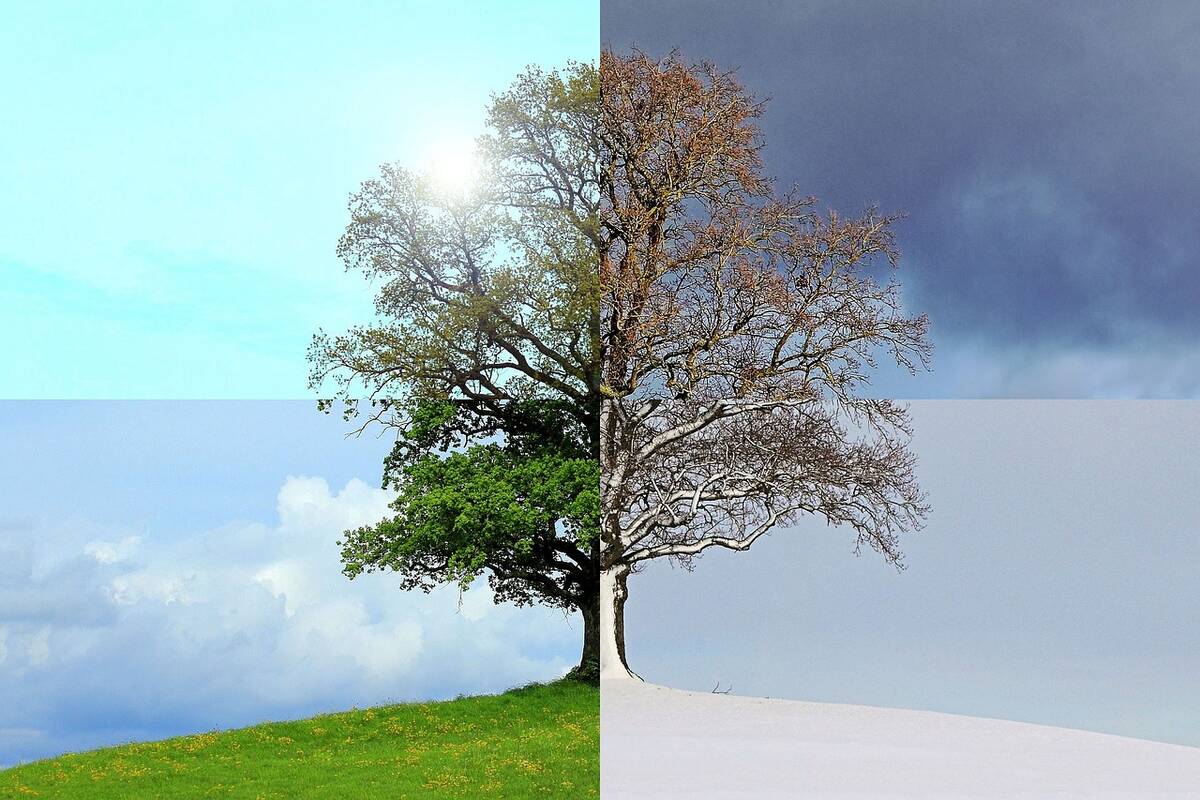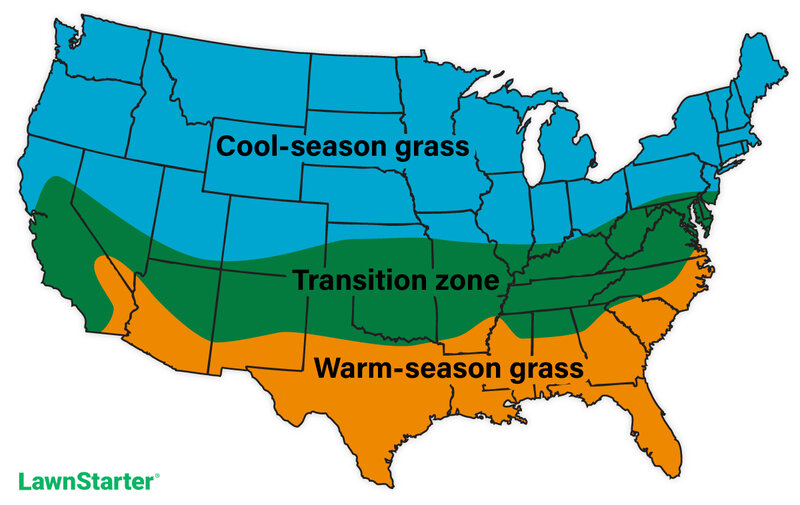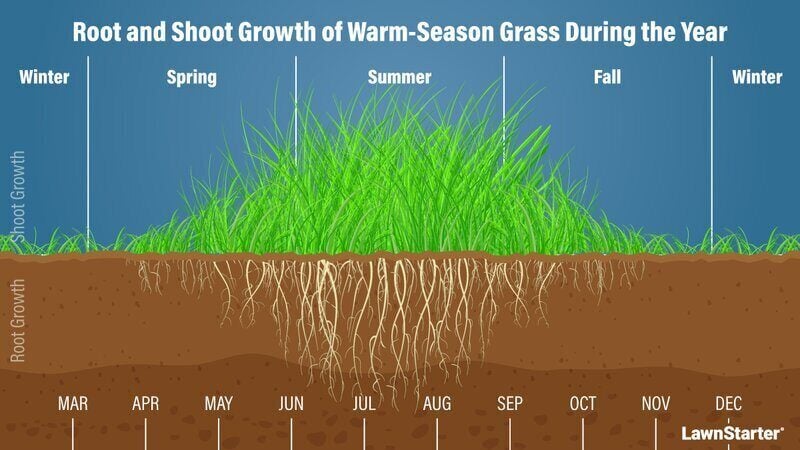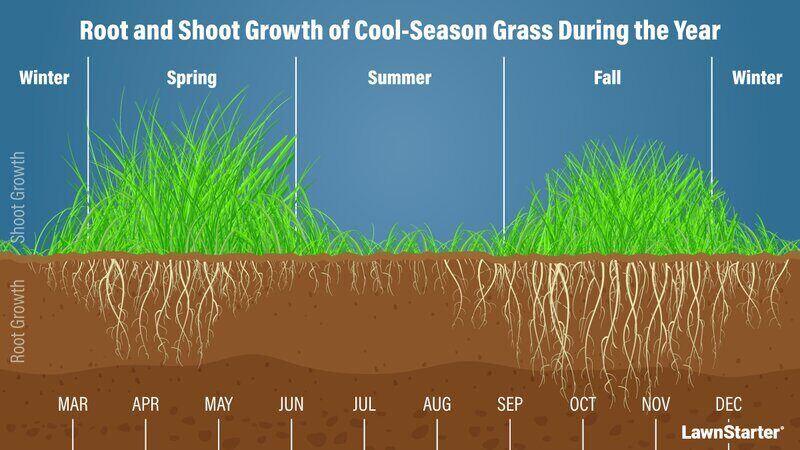
The transition zone is the growing area across the middle of the U.S., one between the warm area in the south and the cool area in the north. This guide to growing grass in the transition zone will help homeowners weigh the pros and cons of each grass type to select and plant the best grass for their transition zone yard.
Grasses Good to Grow in the Transition Zone

Transition zone grasses are divided into two categories: warm-season grasses and cool-season grasses. You will want to consider which one is the best transition zone grass for you:
- Cool-season grass: These grasses struggle to grow during the hot summer months unless you give supplemental irrigation. The upside to this is they are low-maintenance in the summer compared to warm-season grasses since you’ll get out your mower less often.
LawnStarter has prepared a report on cool-season grasses. - Warm-season grass: These grasses will give you a lawn to use in the summer to host lawn parties or play with the kids. But they will go dormant in the winter and won’t green up as quickly in the spring.
LawnStarter has prepared a report on warm-season grasses.
North Carolina State University Extension recommends these grasses for planting in the transition zone:
Cool-Season Grasses to Grow in the Transition Zone
| Kentucky Bluegrass (Poa pratensis) | Perennial Ryegrass (Lolium perenne) | Tall Fescue (Festuca arundinacea) | |
| Tolerances | |||
| Can it be seeded | Yes | Yes | Yes |
| Shade tolerance | Good | Good | Good |
| Heat tolerance | Good | Fair | Good |
| Cold tolerance | Very good | Very good | Very good |
| Drought resistance | Very good | Good | Very good |
| Wear | Very good | Very good | Very good |
| Appearance | |||
| Color | Medium-dark | Medium-dark | Medium |
| Texture | Medium-course | Medium | Medium-course |
| Rate to establish | Fast | Fast | Fast |
| Maintenance | |||
| Mowing height | 2.5-3.5 inches | 1.5-2.5 inches | 2.5-3.5 inches |
| Fertilizer | 2-4 lb. of nitrogen per 1,000 sq. ft | 2.5-3.5 lb. of nitrogen per 1,000 sq. ft | 2-4 lb. of nitrogen per 1,000 sq. ft |
| Mowing frequency | High | Medium high | High |
Pro tip: Fine fescue is an additional cool-season grass to consider with this caveat: It should be mixed with other grasses, such as Kentucky bluegrass or tall fescue. Fine fescue can tolerate partial shade and is often used in a grass seed mix for lawns with some shade.
Warm-Season Grasses to Grow in the Transition Zone
| Zoysiagrass (Zoysia japonica) | Bermudagrass (Cynodon dactylon) | |
| Tolerances | ||
| Can it be seeded | Yes (but seeding is rarely recommended) | Yes |
| Shade tolerance | Good | Very poor |
| Heat tolerance | Very good | Excellent |
| Cold tolerance | Good | Poor |
| Drought resistance | Excellent | Excellent |
| Wear | Very good | Excellent |
| Appearance | ||
| Color | Medium-dark | Medium |
| Texture | Fine-medium | Medium |
| Rate to establish | Very slow | Fast |
| Maintenance | ||
| Mowing height | 0.75-2 inches | 0.75-2 inches |
| Fertilizer | 1-3 lb. of nitrogen per 1,000 sq. ft | 4-4.5 lb. of nitrogen per 1,000 sq. ft |
| Mowing frequency | Low | Med-high |
Pro tip: Don’t try to mix warm-season grasses with cool-season grasses. You will end up with a lawn of patches of different colors and textures. You can have success with a mixture of same-season grasses.
Comparing Warm-Season and Cool-Season Grasses
| Warm-season grasses | Cool-season grasses | |
| Growing season | Summer | Spring and Fall |
| Planting time | Late spring/Early summer | Fall |
| Dormancy | Winter. Will probably turn brown. | Summer. Might turn brown. Should stay green in winter. |
| Temperature preference | 80-95 degrees F | 60-75 degrees F |
| Seasons of the year | Can withstand hot summers, but may die off in cold winters | Can withstand cold winters, but not harsh summers |
Comparing warm-season and cool-season grasses using a checkmark system:
| Topic | Warm-Season Grasses | Cool-Season Grasses |
| Cost for seed | ✔✔ Relatively inexpensive | |
| Soil conditions | ✔✔ Tolerate poor soil better | |
| Growth | ✔✔Produce a dense lawn quicker, within 1 to 2 years | |
| Drought tolerance | ✔✔ Can handle dry soil or periods of drought |
When to Plant Grass in the Transition Zone
Plant warm-season grasses in the late spring and early summer. Plant cool-season grasses in the fall. In both cases, this is the time right before peak growth.


Picking a Grass Type for Your Transition Zone Lawn
When choosing a strategy for growing a lawn in the transition zone, it is important to evaluate your yard carefully. LawnStarter provides these tools:
- Check the soil pH: Look at the ABCs of preparing and sending a soil test.
- Determine the soil type: It matters for a healthy lawn. Knowing your soil type will assist you in preparing the soil before you plant.
- Calculate sun exposure: Make a note of full sun or levels of shade over a normal day.
The easiest way to choose a turf type for your transition zone lawn is to see which grasses grow well in your area. In addition, consider whether you mind a dormant lawn in the summer (cool-season grasses) or would rather have a dormant lawn in the winter (warm-season grasses).
You’ll also need to ensure the type of grass you choose has the hardiness to withstand the winter without dying. Cool-season lawns may be a better fit for winters that are on the colder side.
Cost to Plant Grass in the Transition Zone
A LawnStarter study found that having a professional seed or reseed a lawn costs between $0.10 and $0.19 per square foot. The average price for a job:
| National average cost | $1,085 |
| Typical price range | $680-$1,815 |
| Extreme low-end cost | $195 |
| Extreme high-end cost | $2,960 |
A further LawnStarter survey reviewed the cost of having sod installed as new grass:
- Sod alone (no labor) costs $0.30 to $0.83 per square foot.
- Labor from a service will run from $0.57 to $0.93 per square foot to install the sod.
- In total, it costs $0.87 to $1.76 per square foot for both labor and materials.
FAQs
Is Climate Change a Factor?
Climate change is believed to be creating a gradual increase in the average temperatures of the transition zone. This leads some to prefer using warm-season grasses in the transition zone.
What is the Fastest-Growing Grass for the Transition Zone?
Perennial ryegrass is considered the fastest-growing turfgrass a homeowner might use for a new lawn. It has an excellent germination rate and a good ability to stand up to foot traffic. Seeds will start sprouting in 10 days.
What is the Best Source of Information for Selecting a Grass?
Contact your county Extension office and local landscaping companies or seed/sod suppliers to get a better idea of the best transition zone grass for your local climate. Choosing the right seed for your climate and lawn’s conditions is the best way to get started on the path to a green lawn.
Is There Maintenance Specific to Transition Zone Grass?
- By overseeding Bermuda with annual ryegrass, cool-season grass seed can be interspersed in a warm-season lawn to provide a green color year-round. You can also overseed bare spots during the growing season.
- All lawn grass can benefit from aeration, something to consider, especially if you overseed.
- The grass types that do best in the transition zone tend to produce more thatch from stolons and rhizomes, so you will want to consider regular dethatching.
- You will want to learn about mulch and how to apply it around trees and flower beds.
- Weed control is a necessity for many homeowners, no matter what grass you have. Remember to choose a pre-emergent herbicide that won’t damage your turf.
A Call to Action
If you live in the transition zone, make it a point to review what kind of grass you want to plant. But be sure to take action: Review your situation, decide on the right grass for you, and decide if you want to install it on a DIY basis or if you want to call in a professional landscaper.
Once installed, contact a local lawn care pro to mow, edge, and keep your lawn neat and tidy.
Main Image Credit: Pixabay